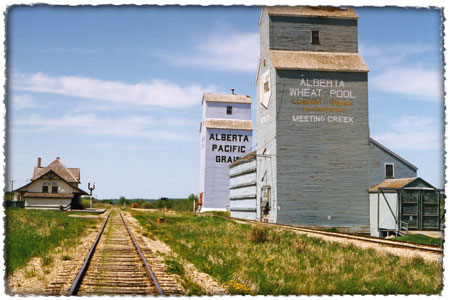The mid-west can only agriculturally support something that can grow in the often cantankerous soil. The southern Canadian prairies, supporting both brown and black soil types, are semi-arid and can be highly prone to frequent and severe droughts (see link below). The region known as Palliser's Triangle is so arid that farming is only successful there with much labour, irrigation, and often government aid.
 The northern prairies are a cold and windy area. Crops cannot survive there because of the weather conditions, in an average year, southern Saskatchewan receives between 300 mm (12 in) and 510 mm (20 in) of precipitation, with the majority falling between April and June. Frost from October to April (and sometimes even early May) limits the growing season for certain crops. More than half of the prairies' precipitation falls as snow.
The northern prairies are a cold and windy area. Crops cannot survive there because of the weather conditions, in an average year, southern Saskatchewan receives between 300 mm (12 in) and 510 mm (20 in) of precipitation, with the majority falling between April and June. Frost from October to April (and sometimes even early May) limits the growing season for certain crops. More than half of the prairies' precipitation falls as snow.
The people of the Prairies have put blood, sweat and tears into making their land the agricultural powerhouse it is today. When settlers arrived in Canada the fur trade was the immediate attraction, but once this started to become an overpopulated job and underpopulated work they had to look elsewhere to find a means of survival. Wheat started to be planted at the end of the nineteenth century in Canada and we are currently the 6th highest wheat producer in the world. Within Canada, wheat is the largest agricultural product with the biggest cash receipt. We keep wheat both for our own use as well as an export to other countries.
Many farmers banded together in the early twentieth century to demand a fair price for their wheat and many companies were formed in co-operation between the wheat farmers. to name a few there is the Territorial Grain Growers Association, the Farmers Union of Canada which launched the Wheat Pool in 1924. Still today there is the Saskatchewan Wheat Pool which does marketing and international alliances and has become the largest agriculture grain handling operation. The flag for the province of Alberta contains an animated picture of wheat in the foreground and the Rocky Mountains in the background. Saskatchewan also has pictures of wheat incorporated into their flag. This image of wheat blowing in the wind is something that is engraved in every Canadian’s mind when thinking of the Prairies.





















No comments:
Post a Comment